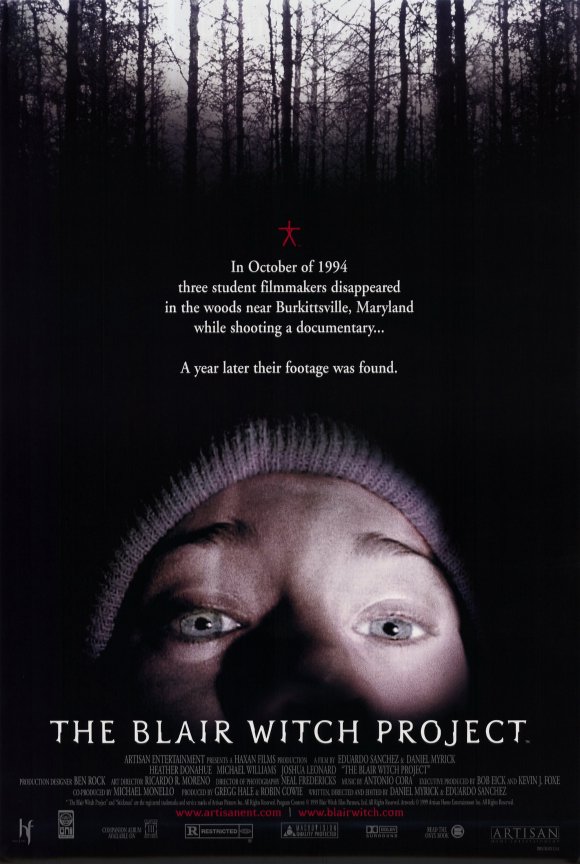 |
| Fig. 1: The Blair Witch Project poster. |
A handheld camera is carried around shakily by unskilled hands, often focusing on nothing at all, being used more to capture sound than image in many places; "The first few minutes are disorienting, deliberately shot with all the shakiness of raw footage from some backpacker's video diary. The actors, using their real names, swiftly establish soon-to-fray relationships" (Thomas, 2000). The characters seem real from the beginning, with their scruffy clothes and playful conversations that don't seem at all forced. They joke, argue and even break into song in a way that feels natural, and their fear and annoyance at each other match that of the audience. When Josh and Mike are angry with Heather for pretending they're not lost, the audience is angry with her too, and when Mike reveals he's disposed of the map, the audience experience the same resentment towards him.
 |
| Fig. 2: Heather Donahue. |
The build up of fear is well executed and slow. There are no sudden jump scares to keep the audience on their toes, instead they wonder where the first jump scare will be, or when they will see the mysterious entity following the group through the woods. As the characters become more scared and stressed, so does the audience, and viewing everything through the camera makes the audience feel immersed in the events, like a silent fourth character. It is not obvious anything bad is going to happen at first; after the groups' first night in the woods, Josh casually remarks that he thinks he could hear cackling in the distance during the night, and even on the next night, when the group can hear noises all around the tent, they comment on how weird it is, but do not seem too frightened by it.
 |
| Fig. 3: The stick figures. |
The film's ending is incredibly unnerving. Josh is missing, but Heather and Mike believe they can hear him screaming. It's worth noting at this point that Heather has reason to believe Josh is dead, as a bundle of twigs containing Josh's shirt, teeth and hair was left outside the tent. Mike has no knowledge of this, and so believes Josh must be alive and trapped. They come across a house, made more odd by the fact that they had been travelling in circles all throughout the day and have not previously seen it. Mike immediately runs in, believing he can hear Josh upstairs. He is carrying the larger camera, and shots quickly switch between the larger camera and Heather's, making the event more chaotic.
As they ascend the stairs, there are dozens of children's hand prints along the walls. Upon reaching the attic, they find no sign of Josh, before Mike quickly runs downstairs believing he could hear Josh again. Mike goes to the basement and suddenly drops his camera. This has great dramatic effect, slowing the chaos suddenly as the audience can only see from Heather's point of view, as she slowly makes her way down to the basement. She screams continuously, turning to see Mike stood in the corner of the basement, facing the wall. The camera is knocked from her hands, her screams turn to silence and there is a few more seconds of footage before the film ends.
 |
| Fig. 4: The last shot of Mike. |
"At a time when digital techniques can show us almost anything, "The Blair Witch Project" is a reminder that what really scares us is the stuff we can't see. The noise in the dark is almost always scarier than what makes the noise in the dark. Any kid can tell you that." (Ebert, 1999).
Images:
Figure 1: The Blair Witch Project poster. (1999) [poster] At: http://www.moviepostershop.com/the-blair-witch-project-movie-poster-1999 (Accessed on: 03.05.2016)
Figure 2: Heather Donahue. (1999) From: The Blair Witch Project. Directed by: Daniel Myrick and Eduardo Sánchez [Film still] United States: Haxan Films. At: http://www.theloop.ca/shocking-but-true-facts-about-the-blair-witch-project/ (Accessed on: 03.05.2016)
Figure 3: The stick figures. (1999) From: The Blair Witch Project. Directed by: Daniel Myrick and Eduardo Sánchez [Film still] United States: Haxan Films. At: http://www.theloop.ca/shocking-but-true-facts-about-the-blair-witch-project/ (Accessed on: 03.05.2016)
Figure 4: The last shot of Mike. (1999) From: The Blair Witch Project. Directed by: Daniel Myrick and Eduardo Sánchez [Film still] United States: Haxan Films. At: http://www.theloop.ca/shocking-but-true-facts-about-the-blair-witch-project/ (Accessed on: 03.05.2016)
Bibliography:
Ebert, R. (1999) 'The Blair Witch Project' In: rogerebert.com 16.07.1999 [online] At: http://www.rogerebert.com/reviews/the-blair-witch-project-1999 (Accessed on: 02.05.2016)
Thomas, W. (2000) 'The Blair Witch Project Review' In: Empire 01.01.2000 [online] At: http://www.empireonline.com/movies/blair-witch-project/review/ (Accessed on: 02.05.2016)
Travers, P. (1999) 'The Blair Witch Project' In: Rolling Stone 30.07.1999 [online] At: http://www.rollingstone.com/movies/reviews/the-blair-witch-project-19990730 (Accessed on: 02.05.2016)
The Blair Witch Project (1999) Directed by: Daniel Myrick and Eduardo Sánchez [DVD] United States: Haxan Films.

No comments:
Post a Comment